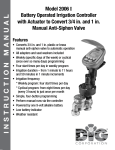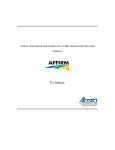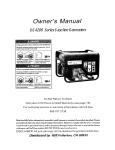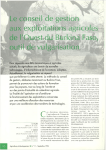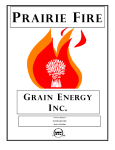Download - Alberta Agriculture and Rural Development
Transcript
ENERGY F IRST S TEPS to Energy Management MONEY h Save Energy & Money Lakenman, K. and Lewis, T. 2003. First Steps to Energy Management: Save Energy and Money. Alberta Agriculture, Food and Rural Development. Edmonton, Alberta. Published by: Alberta Agriculture, Food and Rural Development 7000 - 113 Street Edmonton, Alberta T6H 5T6 © 2003. All rights reserved by her Majesty the Queen in Right of Alberta. F IRST S TEPS No part of this publication may be reproduced, stored in a retrieval system or transmitted in any form or by any means, electronic, mechanical, photocopying, or otherwise without permission from Alberta Agriculture, Food and Rural Development. Printed in Canada Sample energy bills provided courtesy of EPCOR, ATCO Gas and ESSO Imperial Oil. Copies of this publication are available from Alberta Agriculture, Food and Rural Development: All Alberta government offices can be reached toll-free by dialling 310-0000: Agriculture Information Centre: 1-866-882-7677 • Publications: 1-800-292-5697 • AgTech Centre: 1-403-329-1212 • Conservation and Development Branch: 1-780-422-4385 • FIRST STEPS to Energy Management C ONTENTS Energy management and your farm ......................................................................................................................1 Energy accounting ...................................................................................................................................................2 How to track your electricity costs ............................................................................................................3 Electricity bill tracker ..................................................................................................................................4 How to track your natural gas costs ..........................................................................................................5 Natural gas bill tracker.................................................................................................................................6 How to track your diesel costs....................................................................................................................7 Diesel bill tracker ..........................................................................................................................................8 How to track your gasoline costs................................................................................................................9 Gasoline bill tracker ...................................................................................................................................10 Bill tracker summary ................................................................................................................................. 11 Next steps: Towards action on energy management ......................................................................................12 Energy saving tips........................................................................................................................................13 Example of walk-through energy assessment questions......................................................................15 Calculating the payback period for energy systems .............................................................................16 For more information ............................................................................................................................................17 Energy accounting terms......................................................................................................................................18 References ...............................................................................................................................................................19 It is easier to save a watt then it is to produce a watt. 1 h FIRST STEPS to Energy Management It is easier to save a watt then it is to produce a watt. E NERGY MANAGEMENT FOR YOUR FARM Energy costs are a significant portion of total operating costs for many farms. Costs for energy sources, like natural gas, diesel, gasoline and electricity, can vary greatly, sometimes spiking unexpectedly. Improving energy management on your farm will help reduce your energy costs and lessen the impacts of price fluctuations. And better energy management is also better for the environment! Energy management involves five main steps: 1. 2. 3. 4. 5. adding up your energy consumption and costs, called energy accounting assessing your options to reduce energy use and costs developing an action plan to make your priority changes implementing your plan, and beginning the process again to assess the effects of implementing your plan. The process needs to be done on a regular basis and more often when large operational changes occur. IN THIS PUBLICATION This booklet provides a straightforward approach to energy accounting, the first step in the energy management process. Energy accounting is the foundation for beginning to improve energy management on your farm. It helps you to see exactly how much energy you are using and what it is costing you. Completing this first step of the energy management process will: • demonstrate how important energy use is for your farm operation • identify the energy costs for each energy use on your farm, and • identify any spikes in your energy use The results from energy accounting may also suggest some simple, lowcost changes that could save a significant amount of money. To help you move towards making such changes, this booklet includes some tips for improving energy efficiency or reducing energy use. And if you do make some changes, the information from energy accounting will provide a baseline to assess the effects of the changes. Your energy accounting results will be unique to your farm. Farms vary widely in terms of size, type of operation, climate and soil conditions, number and age of people living on the farm, and distance to town, so no two farms have the same energy use. FIRST STEPS to Energy Management E NERGY It is easier to save a watt then it is to produce a watt. ACCOUNTING H AVE This section provides a simple way to add up and assess the consumption and costs for each of the energy sources used on your farm. 2 h YOU EVER WONDERED ... what an increase in the cost of electricity or natural gas really means to your bottom line? Here are two examples for an irrigated crop production: The energy accounting process involves five steps: 1. Gather 12 months of energy billing information for your farm. Remember to include the bills for all your energy sources. These will likely include electricity, natural gas, diesel fuel and gasoline. They may also include other sources such as solar power, biomass, propane and coal. • • Every 1¢/kWh increase in the cost of electricity will cost the average irrigation producer $2 to $3/acre more to apply irrigation water to the crop. Every $1/GJ increase in the cost of natural gas will cost the average irrigation producer $3 to $4/acre more to apply irrigation water to the crop. 2. Sort the bills by energy source. If you have several meters for the same energy source or supplier, also sort the bills by meter. 3. Complete the bill trackers for the energy sources used on your farm. On the following pages, you'll find a series of sample energy bills and bill trackers for four common energy sources. Each bill tracker requires energy use and cost information for 12 months. Twelve consecutive months is usually the minimum period needed to demonstrate energy use in one production cycle and to assess the factors affecting energy consumption and costs. The first line of each tracker shows an example from the sample bill. Each tracker also includes a column for Comments, for you to note anything that seems odd or different, such as a big jump in consumption, and to record if the reading is actual or estimated. Some of the bill trackers may need to be modified to accommodate your specific bills. “ h C OMPLETING your own energy audit will take a little time and effort, but it’s well worth it because defining and understanding ” your energy usage is half way to improving it. Paul Hunt, ITS – Energy & Environment Services The bill trackers look only at energy consumption and the cost of consumption. They do not include other charges such as taxes, distribution and transmission charges, or fixed monthly charges. If you want to compare the costs for different energy sources, you will need to include these additional charges. The bill trackers cover only the most common energy sources: electricity, natural gas, diesel fuel and gasoline. If you use other energy sources, such as wind, solar, coal or propane, you'll need to include the use and costs for those sources too. You may be able to do this by modifying one of the bill trackers to suit your needs. For renewable energy sources, like wind and solar, you'll need to factor in the capital costs for equipment and to calculate the value of the energy you use (see Calculating the payback period for energy systems on page 16). 4. Complete the bill tracker summary. 5. Consider what the results from the bill tracker summary mean in terms of your energy use and what changes you might make to reduce your use. The summary form includes some key questions to help you assess your energy use and possible options for changes. 3 h FIRST STEPS to Energy Management It is easier to save a watt then it is to produce a watt. H OW TO TRACK YOUR ELECTRICITY COSTS The following is a sample of an electricity bill. The circled numbers show what billing information needs to be recorded on the bill tracker. 2 The bill tracker may need to be modified to accommodate your electricity bills. 1 1 Utility Company 1 Utility Company 4 2 Account Number 3 Meter Location/Metered use (see bill tracker, next page)- use this if you have multiple meters on your farm or to identify the metered use 4 Billing Period 5 Electrical Energy Used (kWh) 6 Rate (cost/kWh) 7 Cost of Electrical Energy ($) 8 Date of Last Meter Reading 9 Actual Meter Reading Source: EPCOR. 2003. Understanding Your EPCOR Bill- Electricity Billing. [on line] http://www.epcor.com/Farms/Your+Bill/Unders tand+Your+Bill/Electricity+Billing.htm [accessed January 2003] 9 2 Account Number 8 3 Meter Location/Metered use 5 (see bill tracker, next page)- use this if you have multiple meters on your farm or to identify the metered use 4 Billing Period 6 5 Electrical Energy Used (kWh) 7 6 Rate (cost/kWh) 7 Cost of Electrical Energy ($) 8 Date of Last Meter Reading 9 Actual Meter Reading FIRST STEPS to Energy Management It is easier to save a watt then it is to produce a watt. Utility Comapany: Account Number: E LECTICAL BILL TRACKER Use a new sheet for each meter on your farm. Meter Location/Metered Use: Billing Period Electrical Energy Used (kWh) Rate (¢/kWh) Cost of Electrical Energy($) 4 5 6 7 Oct 16-Nov 14 25.06 5.6 1.40 1 2 3 4 T IP 5 Flourescent lighting is about four times more efficient than incandescent and lasts 10 times longer. Replacing one 90 watt incadescent bulb with one 23 watt compact fluorescent will save 67 watts. The cost-savings of this change, based on use for 8 hours a day, 365 days a year, is: 6 a. if electricity rate is $0.06/kWh: $11.74 per bulb 10 7 8 9 11 b. if electricity rate is $0.10/kWh: $19.56 per bulb 2 3 Meter Reading Record billing information for at least 12 months. The first line of the tracker shows an example from the sample bill. 1 4 h 12 TOTAL 8 Date of Last Reading 9 Actual Meter Reading Aug 14 27399 Comments Estimates. Comsumptions seems o.k. 5 h FIRST STEPS to Energy Management It is easier to save a watt then it is to produce a watt. H OW TO TRACK YOUR NATURAL GAS COSTS The following is a sample of a natural gas bill. The circled numbers show what billing information needs to be recorded on the bill tracker. The bill tracker may need to be modified to accommodate your natural gas bills. 1 2 1 Supplier 2 Account Number 3 Meter Location/Metered use (see bill tracker, next page)use this if you have multiple meters on your farm or to identify the metered use 4 5 6 7 4 Billing Period 5 Days 6 Energy Used (GJ) 7 Rate ($/GJ) 8 Cost of Gas ($) Source: ATCO Gas. 2003. Your Bill. [online] http://www.atcogas.com [accessed January 2003.] 8 FIRST STEPS to Energy Management It is easier to save a watt then it is to produce a watt. 1 Supplier: 2 Account Number: N ATURAL GAS BILL TRACKER Use a new sheet for each meter on your farm. The first line of the tracker shows an example from the sample bill. Billing Period Days 4 5 Nov 7-Dec 4 1 2 3 4 5 6 7 YOU CAN... increase heating efficiency by: 3 Meer Location/Metered Use: Energy Used (GJ) Record billing information for at least 12 months. 8 9 • ensuring doors and windows fit tightly. 10 • replacing worn weather stripping. 11 • caulking all building joints. 12 TOTAL 27 6 23 4 2.91 2.27 .64 Rate ($/GJ) 7 5.682 5.462 6 h Cost of Gas ($) Comments 8 16.40 Cold Snap. Cost higher then usual. Estimate 7 h FIRST STEPS to Energy Management It is easier to save a watt then it is to produce a watt. H OW TO TRACK YOUR DIESEL COSTS Diesel fuel refers to dyed diesel, purple fuel, or farm fuel. The following is a sample of a diesel bill. The circled numbers show what billing information needs to be recorded on the bill tracker. The bill tracker may need to be modified to accommodate your diesel bills. 6 1 3 4 DID YOU KNOW The Alberta Government is already helping to reduce on-farm energy costs with the Alberta Farm Fuel Distribution Allowance (AAFRD). Farm fuel dealers are reimbursed with a credit of: 5 1 Supplier 2 Account Number • • $0.09/litre for gasoline (January 2003) 3 Delivery Date $0.15/litre for diesel fuel (January 2003) and the dealers pass it on to Alberta farmers and ranchers. 5 Rate ($/litre) The credit results in a saving of $15 on a 100-litre tank of diesel fuel. On an annual basis, it provides a major cost-savings for every farm in Alberta. Source: Courtesy of ESSO Imperial Oil. 2003. 4 Consumption (net volume litres) 6 Cost of Diesel Fuel ($) 2 FIRST STEPS to Energy Management It is easier to save a watt then it is to produce a watt. Supplier: D IESEL FUEL BILL TRACKER Account Number: 1 2 Record billing information for at least 12 months. Delivery Date Consumption 3 4 5 6 13918.0 0.3970 5525.45 The first line of the tracker shows an example from the sample bill. Dec. 14, 2002 1 2 3 4 5 6 7 TIP 8 Using the correct tire inflation pressure on your tractor conserves energy and saves time and money. For a 640-acre field, you can save about $352 plus 2 hours and 20 minutes for farm operations each year, just by using the correct tire pressure. 9 10 11 12 TOTAL Rate ($/litre) Cost of Diesel Fuel ($) Comments Typical 8 h 9 h FIRST STEPS to Energy Management It is easier to save a watt then it is to produce a watt. H OW TO TRACK YOUR GASOLINE COSTS The following is a sample of a gasoline bill. The circled numbers show what billing information needs to be recorded on the bill tracker. The bill tracker may need to be modified to accommodate your gasoline bills. 1 3 2 4 6 1 Supplier 2 Account Number 3 Delivery Date 4 Consumption (net volume litres) 5 Rate ($/litre) 6 Cost of Gasoline ($) Source: Courtesy of ESSO Imperial Oil. 2003. 5 FIRST STEPS to Energy Management It is easier to save a watt then it is to produce a watt. Supplier: G ASOLINE BILL TRACKER Account Number: Record billing information for at least 12 months. Consumption Rate ($/litre) Cost of Gasoline ($) 3 4 5 6 2176.8 0.3990 868.54 Dec. 14, 2002 1 2 3 4 5 6 7 On average, farm energy costs can be reduced by 10 to 15% by practicing proper maintenance and making minor modifications to operating practices. That’s $10 to $15 saved on every $100. 8 Actual cost-savings will depend on how energy efficient your operation was before your energy accounting. 11 2 Delivery Date The first line of the tracker shows an example from the sample bill. TIP 1 9 10 12 TOTAL Comments High. Had to pump water from dugout 10 h 11 h FIRST STEPS to Energy Management It is easier to save a watt then it is to produce a watt. B ILL TRACKER SUMMARY Now that your bill trackers are complete, you need to assess the results. During the course of a year, there may be fluctuations and inconsistencies in the bills, seasonal and production peaks, production changes, price fluctuations, billing errors, and adverse weather conditions. reduce costs. If you find many inconsistencies or unknowns when answering the questions, you will need more information. For example, you may need to complete bill trackers for another year or more to get a clearer picture of your energy use. Answering the questions in this summary form will help you to analyze your energy use and costs, and to start thinking about possible changes to Farm Name: Date of Energy Accounting: Energy Type Electricity Total Energy Total Cost Consumption Interpreting Questions Is this 12-month period typical of energy use on your farm? Was this a typical production period? Were there large energy price fluctuations? Natural Gas Are there billing inconsistencies? Diesel Fuel Have production and operating practices changed? Were there consumption fluctuations that were not related to production? Gasoline Did weather affect production and operation of the farm? (e.g. drought, wet year) Have buildings been maintained? Other Energy Sources Has equipment been maintained? Answers/Comments FIRST STEPS to Energy Management It is easier to save a watt then it is to produce a watt. 12 h N EXT STEPS: TOWARDS ACTION ON ENERGY MANAGEMENT TIP Now that you have completed the bill tracker summary, you have a good understanding of your energy use in terms of your operation's production cycle, and what that energy use is costing you. The next step to improving energy management is a walk-through energy assessment, a close look at energy use in each farm building and each piece of equipment. • Can windows and doors be improved or should they be replaced? • Could automated controls help to save energy? To help you begin this process, here are some questions you can ask during your initial walk-through to look for problems and possible solutions: Try to involve your family and farm workers in this step. Each person will have ideas about where and how energy inefficiencies can be improved. • Has equipment been regularly maintained? • Have buildings been regularly maintained? • Does equipment need to run as long? • Can operating temperature be reduced? • Can more efficient equipment be installed? • Can insulation be added? Some of the energy saving tips on pages 13 and 14 may help to spark more ideas about things to watch for and possible changes to make. For a comprehensive walk-through energy assessment, you will need to make a much more detailed inspection and ask very specific questions every step of the way. The lighting worksheet on page 15 shows the level of detail and kind of information needed for a comprehensive assessment. You can hire a consultant to assess your energy use and costs, and prepare an action plan for your farm. Costs start at about $150 and increases significantly with the complexity of the operation and the degree to which the plan is tailored specifically to your farm. TIP Energy use is just one aspect of your farm’s operation. The Alberta Environmental Farm Plan (AEFP) program offers a voluntary, confidential self-assessment process for you to evalute your whole farm operation. It helps you identify environmental opportunities and risks on your farm, and then to develop your own action plan to address the risks and realize the opportunities. 13 h FIRST STEPS to Energy Management It is easier to save a watt then it is to produce a watt. E NERGY SAVING TIPS T RACTORS AND EQUIPMENT • Much of the work performed by a large farm tractor is "light load work." It is estimated that a farmer with an annual fuel bill of $2000 could save $400 per year by shifting up and reducing engine speed when doing light work. • Match implements and tractor so the tractor is operating at its full rated load. • • I RRIGATION • S EEDING • Improve tractor fuel efficiency by: maintaining tires at the lowest correct pressure for the load the tires are carrying; using the right fuel for the season; and performing regular maintenance. Fuel-saving measures can also prolong the life of the tractor. • Maintain engines regularly. Poor maintenance schedules can reduce the life of an engine by one-quarter to one-half. • The average tractor gets less than 4,000 hours of operation before an engine overhaul is needed. With proper maintenance, it should get about 6,400 hours before an overhaul is needed. A $9,000 turbocharged engine, amortized over five years, costs a farmer an average of $1,800 per year to own. If maintenance is neglected and it lasts only three years, then the cost goes up to $3,000/year, plus the cost of overhauling the engine. • If the load on the tractor reduces the engine speed to less than half of its original setting, cylinder wall scarring may occur due to improper lubrication. Use the gear-speed ratio recommended in the user's manual to prevent needless repairs. • Keep a list of all electric motors in use, and record the preventive maintenance measures performed on each to be sure they are checked, cleaned and lubricated regularly. Irrigate at the right time and apply just the amount of water required by the crop. This will result in better crop yields, less water lost to deep percolation and runoff, and lower energy costs. The annual cost for fuel and lube for the seeding operation (including seed placement, fertilizer placement, and tillage if used) varies with the tillage system. For example, seeding 2000 acres on an Alberta farm costs about: $4000/year ($2.00/acre) for direct seeding; $6200/year ($3.10/acre) for minimum tillage; and $9600/year ($4.80/acre) for conventional tillage. G RAIN DRYING • Newer, more efficient grain dryers can reduce energy consumption by as much as 35%. Energy savings can be increased by using other drying methods, such as aeration, low-temperature drying or combination drying. • Use an accurate moisture tester to determine the precise moisture content of the grain to avoid over-drying. • Dry grain in smaller batches in the bins. This allows the air and heat to pass through the grain so it will dry more easily and quickly, and require less energy. FIRST STEPS to Energy Management L IVESTOCK • When using ventilation fans in livestock buildings, clean fan blades and shutters frequently and routinely to maintain efficiency. • Do not oversize your milking centre vacuum pump; it wastes money and energy. If a 10 HP motor can get the job done but you use a 15 HP motor, the cost of running the 15 HP motor would be almost $1,100 more than the cost of running the 10 HP motor, based on operating the motor 16 hours per day for a year. • Maintain hot water heaters regularly. A clean hot water heater operates at 90 to 95% efficiency. A dirty hot water heater can operate at as low as 73% efficiency. F ARM B UILDINGS • Insulate buildings to recommended levels, based on the heating level required. • Install a continuous air/vapour barrier to keep outside air and moisture from entering a building. • Turn off lights and turn down heat when not needed. • Regularly check and maintain ventilation fans. E LECTRICITY U SE • When possible, use electricity outside of peak demand times (6:30 to 9:00 a.m. and 5:00 to 9:00 p.m.). That will decrease the load on your community's electricity system and decrease the overall electricity costs for everyone on the system. It is easier to save a watt then it is to produce a watt. 14 h 15 h FIRST STEPS to Energy Management It is easier to save a watt then it is to produce a watt. E XAMPLE OF WALK-THROUGH ENERGY ASSESSMENT QUESTIONS This is an example of a worksheet for a comprehensive walk-through assessment to evaluate the energy used for lighting. It shows the type of specific, detailed questions you need to consider when conducting a comprehensive assessment. L IGHTING W ORKSHEET Existing lights and controls (Please use a new sheet for each area, location, or room.) Location of Lights: Date: Types of bulbs and wattage: (Incandescent, fluorescent, etc.) Number and type of fixtures: (If fluorescent tubes, give length of bulbs) Number of bulbs per fixture: Moving Towards Solutions Present light levels: too bright: adequate: too dim: Lights are on: hours/day: days/week: weeks/year: Hours lights could be turned off hours/day: days/week: weeks/year: Can lights be switched on and off as desired? yes no Can lower wattage bulbs be installed? yes no Can more efficient bulbs/fixtures be retrofitted? yes no Are the lights manually controlled? (no timers, sensors, etc.) yes no Is there an automatic timer? yes no yes no yes no yes no yes no yes no Is it set properly? Is there an occupancy sensor? Can an occupancy sensor be installed? Is there a photocell sensor? Can a photocell sensor be installed? FIRST STEPS to Energy Management It is easier to save a watt then it is to produce a watt. C ALCULATING THE PAYBACK PERIOD FOR ENERGY SYSTEMS The payback period is the time required to recapture the investment in a new energy system. This is the simplest way of assessing the cost of a proposed change. 1. Determine your annual energy consumption for the use that you are considering converting to a different energy source. 2. Calculate the current annual cost of that energy use. Be sure to add in all charges and taxes from your bill. 3. Determine how much energy the proposed system will produce. 4. Determine the final installed cost of the proposed system including: • the power production unit (e.g. wind turbine) • the wiring and electrical components such as batteries and inverter (including shipping) • the labour costs for installation 5. Amortize the cost of the proposed system over the system's lifetime or the time required to pay off the loan, adding maintenance and financing costs, to determine a net monthly cost. For example, if the system costs $5000, at a 9% interest rate over 48 months, you would have to pay $124/month. (Various amortizing calculators are available on the Internet, if you need assistance in calculating the payments.) 6. Add up the monthly costs to determine the annual cost of the proposed energy system. 7. Calculate the annual cash inflow. The formula is: annual cash inflow = (annual cost of current energy system) (annual cost of proposed energy system) 8. Calculate the payback period. The formula is: payback period = (cost of proposed project) ÷ (annual cash inflow) So, if a project costs $5,000 and it is expected to have an annual cash inflow of $1,000, the payback period would be $5,000 ÷ $1,000, or 5 years. 16 h 17 h FIRST STEPS to Energy Management It is easier to save a watt then it is to produce a watt. F OR MORE INFORMATION A LBERTA A GRICULTURE , F OOD AND R URAL D EVELOPMENT All Alberta government offices can be reached toll-free by dialling 310-0000 Agriculture Information Centre: 1-866-882-7677 Publications: 1-800-292-5697 • Wind Power Uses and Potential (Agdex 767-2) • A Workbook on Greenhouse Gas Mitigation for Agricultural Producers Website: http://www1.agric.gov.ab.ca (AEFP) Phone: 1-780-436-2336, or toll-free 1-866-844-AEFP (2337) Email: [email protected] Website: http://www.albertaefp.com N ATURAL R ESOURCES C ANADA Energy Resources Branch Publications: 1-800-387-2000 • Heating Your Building with Solar Energy • Solar Water Heating Systems: A Buyer's Guide • Photovoltaic Systems: A Buyer's Guide • Stand-Alone Wind Energy Systems: A Buyer's Guide Website: http://www2.nrcan.gc.ca/es/erb/ Alberta Environmentally Sustainable Agriculture Program Phone: 1-780-422-4385 Website: http://www.aesa.ca AgTech Centre Phone: 1-403-329-1212 Publications: • Focus on Alternative Energy Series • Focus on Alternative Fuels Series • AgTech Centre Innovator, Volume 1, Issues 2 and 4 Irrigation Branch Phone: 1-403-381-5140 Publications: • Strategies for Lowering Irrigation Energy Costs A GRICULTURE AND A GRI- F OOD C ANADA Prairie Farm Rehabilitation Administration A LBERTA E NVIRONMENTAL FARM P LAN (PFRA) Publications: Contact your PFRA district office • Wind-Powered Water Pumping Systems for Livestock Watering • Solar-Powered Water Pumping Systems for Livestock Watering • Livestock-Powered Watering Pumps • Water-Powered Water Pumping Systems for Livestock Watering • Alternatives to Direct Access Livestock Watering. Water Quality Matters. October 2001 Website: http://www.agr.gc.ca/pfra Office of Energy Efficiency Publications: 1-613-943-1590 • Infosearch 2001: Energy Efficiency at Your Fingertips • R-2000 Publications Website: http://oee.nrcan.gc.ca P RAIRIE S WINE C ENTRE I NC . Publications: 1-306-373-9922 • Energy Efficiency in Barns: Part 1 Website: http://adminsrv.usask.ca/psci C ANADA P LAN S ERVICE Phone: 1-519-873-4096 Publications: • 9700 - Fan Ventilation Principles and Rates • 9702 - Troubleshooting Livestock and Poultry Ventilation Problems • 9705 - Selecting Fans for Livestock Buildings • 9710 - Fresh Air Inlets • 9750 - Ventilating and Heating Small Livestock Rooms Website: http://www.cps.gov.on.ca/ FIRST STEPS to Energy Management It is easier to save a watt then it is to produce a watt. E NERGY ACCOUNTING TERMS Account number: the number associated with the energy/fuel provided, so billing charges can be applied to the correct user. For the purpose of energy accounting, account numbers are used to keep track of the different meters and operations, and to keep consistency in the records. Energy used: the amount of energy consumed. Billing period: the time span over which the charges have been measured or calculated. GJ: gigajoule, the metric standard for measuring heat energy. Comments: notes on anything that seems odd or different, like a big jump in consumption, or notes on whether the reading is actual or estimated. Consumption: the amount used. Cost of energy: the energy cost that needs to be paid, not including taxes, distribution and transmission charges, fixed monthly charges, etc. (When comparing different energy sources, these additional charges need to be included.) Days: the number of days at a specific price rate (used when the cost per unit of gas changes during the billing period). Energy accounting: the process of determining where and how much energy is being used and how much it costs. Energy management: a continuing process of regularly assessing energy use and costs, planning changes, and implementing changes, and then beginning the process again by assessing the effects of implementing the changes on energy use and cost. Energy sources: all the different forms of energy used (e.g. electricity, gasoline, propane, etc.). kWh: kilowatt hour, the energy resulting from one kilowatt (1000 watts) operating for one hour. Meter location/metered use: where the meter is located or what the energy is being used for (e.g. irrigation). Rate: the cost per unit of energy. Supplier: the company supplying the energy. Utility Company: the company supplying the energy. 18 h 19 h It is easier to save a watt then it is to produce a watt. FIRST STEPS to Energy Management R EFERENCES Alberta Agriculture, Food and Rural Development, AgTech Centre. 2001. Farmers Can Save Big Money on Fuel. AgTech Centre Innovator, Volume 1, Issue 2. Alberta Agriculture, Food and Rural Development. [on line] http://www.agric.gov.ab.ca/newsletters/agtech/0104.html [accessed January 2003] Alberta Agriculture, Food and Rural Development. 2002. A Workbook on Greenhouse Gas Mitigation for Agricultural Producers. Alberta Agriculture, Food and Rural Development. Alberta Agriculture, Food and Rural Development, Irrigation Branch. 2001. Strategies for Lowering Irrigation Energy Costs. Alberta Agriculture, Food and Rural Development. [on line] http://www.agric.gov.ab.ca/irrigate/lower_irr_costs.html [accessed January 2003] Dunn, R., Zylstra, J. and Erickson, E. 1996. Direct Seeding Economics for the Black and Gray Wooded Soil Zones of Alberta. Alberta Agriculture, Food and Rural Development, Agdex 519-8. [on line] http://www.agric.gov.ab.ca/agdex/500/1900008.html [accessed January 2003] Hunt, Paul D. 2002. Alternative Energy & Distributed Generation Energy Options: Thinking Generations Ahead. Paper presented at AESA 2002 Workshop: Alternative Energy in Agriculture, Keeping our Industry Sustainable, March 5-6, 2002. Hydro One Networks Inc. 2003. Safe and Smart Energy Use in Barns and Outbuildings. Hydro One Networks Inc. [on line] http://customer.hydroonenetworks.com/farm/barns-e6.html [accessed January 2003] Morrison, Leigh. Telephone conversation with T. Lewis, February 18, 2003. New York Farm Bureau. Energy Saving Tips for the Farm. Grassroots, February 2002. [on line] http://www.nyfb.org/periodic/Grassroots/grass0202/energysave.htm [accessed January 2003] N OTES F IRST S TEPS to Energy Management h Save Energy & 2003 Money
























